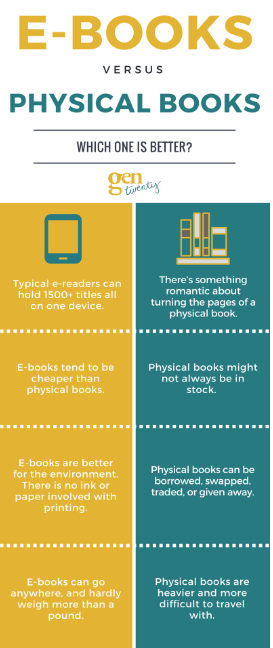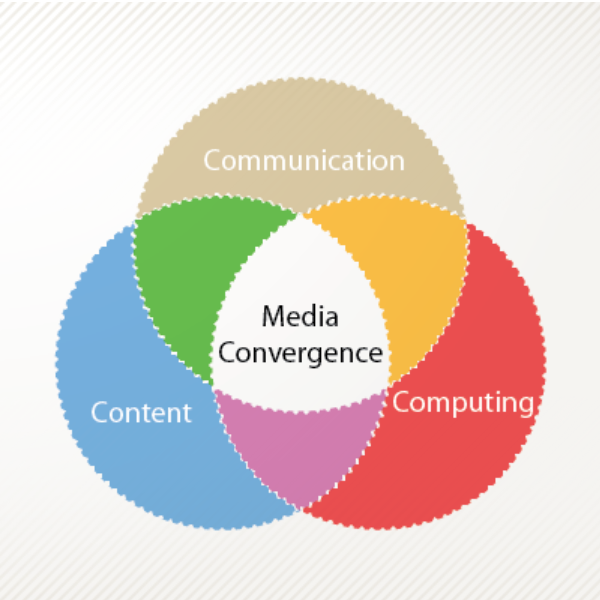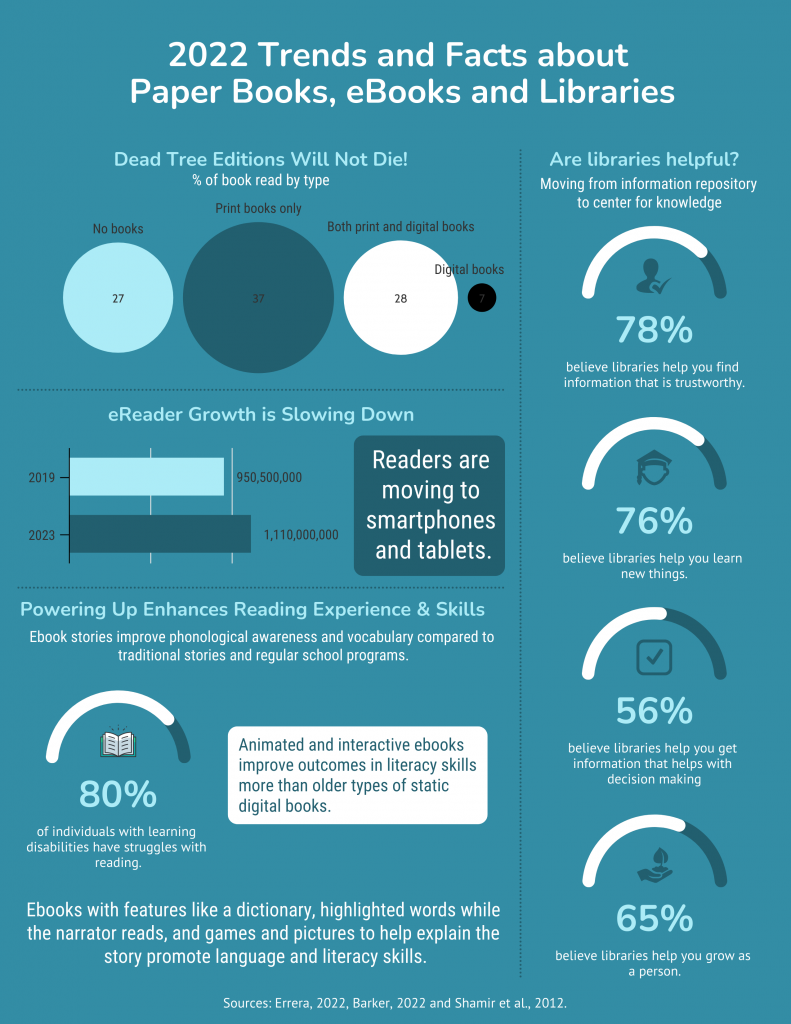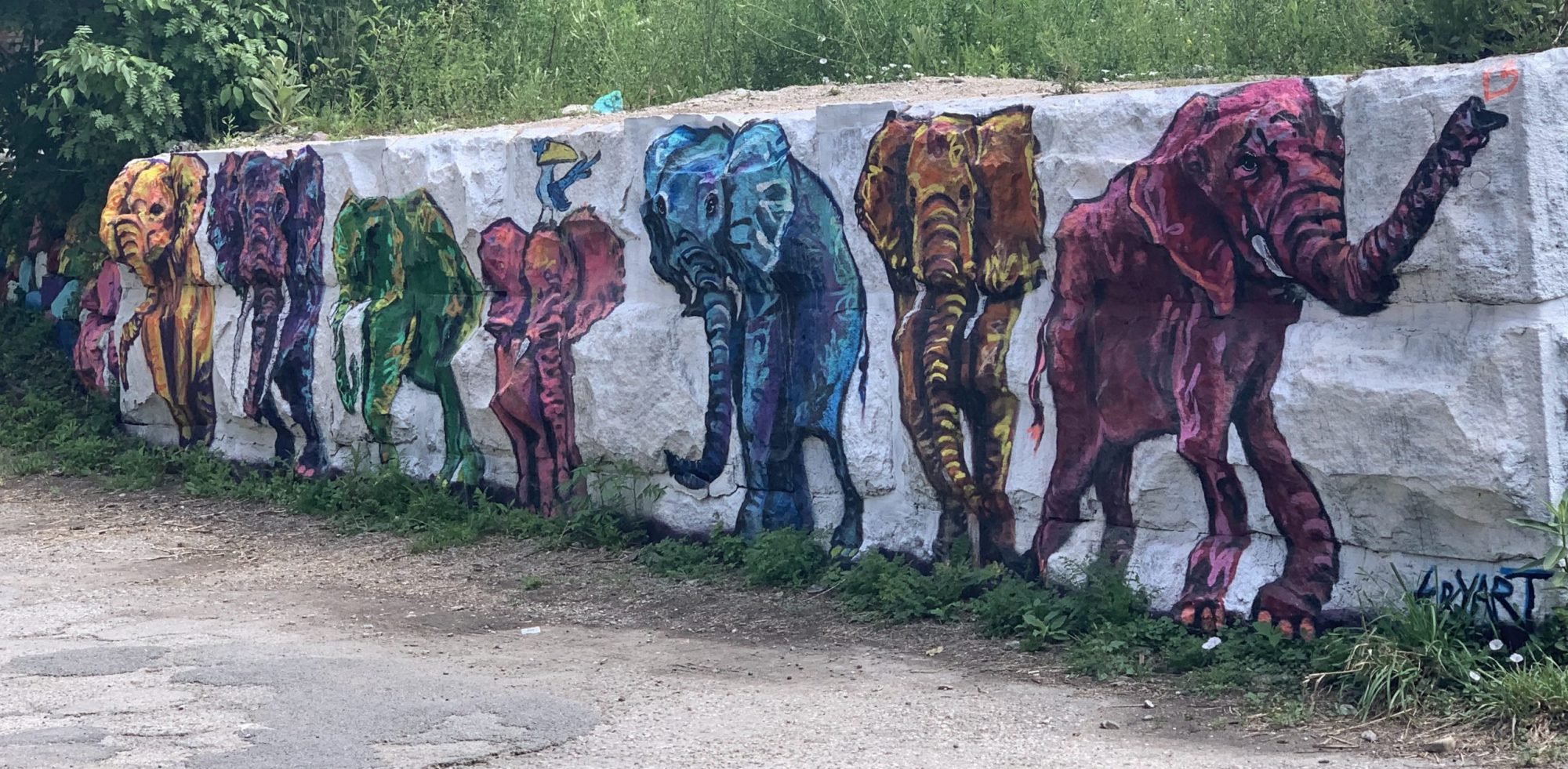Have e-books made reading easier to the detriment of libraries?
By Jamie Husereau and Nicole Kenny
There has barely been an untouched industry by the digital age’s virtual tsunami, libraries and books included (Duncan, 2010). People’s engagement with digital media presents new opportunities, needs, and challenges for libraries and librarians’ education (Tripp, 2011). While eBooks have been around for years, improvements in their versatility, affordability, and increased access to the internet have led to a dramatic rise in ownership (Picton, 2014). Additionally, eBooks can provide options that paper-based books cannot, including interactive dictionaries, text-to-speech, internal highlighting, note-taking, digital drawing, variable font size, and linking (Cavanaugh, 2003).
With the introduction and adoption of eBooks, reading apps, and online media, what has been the impact on literacy and, more importantly, what has or will become of public and school libraries? Using the lens of media convergence, this case study strives to uncover if the advent of eBooks, reading apps, and digital media has displaced libraries but improved reading literacy or required libraries to rethink their place as reading advocates.
So, what is an eBook?

EBooks contain the essential characteristics of traditional print books in electronic format, as well as leveraging the affordances of technology to increase efficiency and ease of use, search functions, embedding features, linking capabilities, and cross-referencing across multiple resources (Abbott, 2003). An eBook is the content itself; it is the author’s intellectual property, and copyright holders own it. In this sense, content in the electronic world can follow the same fair use and copyright regulations regarding sharing content with and among users (Abbott, 2003). The advantages of eBooks include content is easy to access, availability is on-demand, prevention of being lost, stolen, or damaged, search and link functions (including dictionaries and thesauri), no requirements for physical space, content accessibility across devices, transportation ease, and access from anywhere (Abbott, 2003).
As with most things in life, there are potential drawbacks or challenges with eBooks which include but are not limited to; requiring a device to read/access, a power source, possible software to be downloaded, the screens or backlit eReaders can strain your eyes, and they require the technological literacy to utilize the device the viewer is using to access the eBook. Librarians and publishers face challenges with eBooks regarding acquisition and collection development, standards and technology, access, and securing electronic and territorial contractual rights for content and permission clearance, respectively (Abbott, 2003, p. 15).
As eBooks and print books are contentually the same, we can examine whether their functions differ to analyze if one may replace the other (Zhang & Kudva, 2014). As it stands, Zhang and Kudva’s (2014) study support that eBooks have an established place in people’s lives; they have changed the reading landscape and provided a new medium to engage with literacy. However, eBooks have not replaced print books, and only a small portion of eBook readers (11.7%) have abandoned print books altogether (Zhang & Kudva, 2014). Alas, our point in this study is not about the displacement of print books by eBooks. Our study aims to explore in the emergence of eBooks and the displacement of the role of libraries.
From information repository to center for knowledge
Gathering information, storing it, developing systems to retrieve it, and helping others become better users of it have been the responsibility of libraries and librarians throughout history (Mihailidis & Diggs, 2010). Students in today’s libraries are digital natives with a world of information at their fingertips (Mihailidis & Diggs, 2010). The days of searching rows of books for the elusive perfect reference are gone. Libraries must pay close attention to their market and users and adjust service delivery models accordingly (Duncan, 2010). Students and patrons need a more dynamic, collaborative, and participatory library in its approach to sharing information and building engagement (Mihailidis & Diggs, 2010). This participatory approach to librarianship, referred to as “library 2.0”, reflects a commitment to provide resources and services that users need and want, serving the trends of youth library use (Tripp, 2011, p.333).
Suppose it were possible to define the mission of education. In that case, it could be said that its fundamental purpose is to ensure that all students benefit from learning in ways that allow them to participate fully in public, community, and economic life (Jenkins, 2006). To avoid being displaced, libraries must move from an information repository to a center for knowledge. Libraries need to become the drivers for media literacy and participatory culture. The electronic availability of content in all shapes and sizes has led to boundaries between the different media forms established in the print era being no longer valid (Ball, 2009).
Libraries are not just responsible for acquiring and providing holdings and information; they also prepare both to make access easy for readers (Ball, 2009). To avoid displacement, rather than being isolated in a special ‘media corner’ due to their medium, libraries need to integrate eBooks into their electronic information environment (Ball, 2009). While most publishers offer their entire catalogue of titles to libraries, the pricing and business terms may be less than ideal. Libraries continue to pay far more than retail prices for eBook titles, and some publishers allow each licensed copy of an item to be lent a limited number of times (Breeding, 2017). The current business environment places heavy constraints on public libraries’ digital lending services resulting in long queues for popular titles, which means patrons may have to wait for weeks or months to borrow an eBook (Breeding, 2017). This delay in being able to read a title on demand for some patrons leads them to bypass the library’s website or catalogue and go directly to the provider’s platform to find and check out eBooks (Breeding, 2017).
Research indicates that we must pay attention to the powerful and compelling ways young people learn using digital media (Tripp, 2011). If libraries are to fully capitalize on the potential of new media to engage young people in learning, then the education of librarians must be addressed (Tripp, 2011). Although this includes a variety of technical skills, it also includes social skills and cultural competencies related to appropriating and remixing media, contributing to distributed and collaborative productions, circulating and promoting media, and much more (Tripp, 2011). Media convergence, which will be discussed further below, has also been referred to as convergence culture, which represents the merging of technologies or media content (Jenkins, 2006). It can represent how digital media or technological advances have impacted relationships, including the relationships between libraries and their users (Wilson, 2021). In other words, to avoid displacement, the whole gamut of socio-technical competencies is needed to participate actively and appropriately in new media cultures (Tripp, 2011).
Reading for pleasure, not just for school or work
As previously mentioned, the interactive functions found with eBooks support engaging diverse readers, potentially leading to proficient readers and those who read for pleasure (Anderson, 2018). The themes identified in a study conducted with struggling and reluctant readers included increased reading engagement, motivation, positive reading attitudes, reading volume, and reading more accessible through eBooks (Anderson, 2018). According to Anderson’s (2018) study, a potential cyclical pattern of creating lifelong readers is possible through the use of eBooks; reading eBooks was easier and therefore more enjoyable because reading was more fun they had a positive association with reading which increased their motivation to read, their increased engagement increased their ability to read and confidence in their reading abilities, the more confident they were, the easier reading became.
We can use this example of how to harness the potential of new media to engage learners; it is one of many (Tripp, 2011). We should be paying attention to the affordances of technology and how to use it in productive, positive, and influential spaces such as libraries.
Media displacement and media convergence
Media convergence is the merging of media types, a dynamic process that influences how media is produced and consumed (University of Minnesota Libraries Publishing, 2010, p. 20). It is not about all media melding into one – “one black box controlling all media”; rather, convergence happens at “various intersections of media technologies, industries, content and audiences” (Jenkins, 2001, p.93). This may include merging print media (books, magazines, newspapers, journals, eBooks, news apps), broadcast media (radio, television, music apps, streaming websites), and new media (internet, mobile phones, computers) into devices that perform various functions. Popular examples include; Smartphones (converging camera, music, the internet, books, and all other media together), online radio (converging radio with the Internet), eBooks (converging paperbacks with digital technology), news websites and apps (Leverage Edu, 2021). Media convergence brings together the 3 C’s (as depicted below); computing, communication, and content and is a direct consequence of media content digitization and the rise of the internet (Flew, 2017).

As for media displacement, according to Zhang and Kudva (2014), incoming media does not necessarily replace the media previously established but rather changes the situational context in which users interact with the different media types, dividing usage between both instead of replacing one with the other. We know eBooks are not yet positioned to replace print books as they both have unique qualities that serve distinct functions to meet various reading needs; in this way, they complement each other by providing the same content in different media (Zhang & Kudva, 2014). With that being said, and as previously stated, we are not necessarily looking at the replacement of print books but the displacement of the role of libraries in light of the rise of eBooks. As it goes, eBooks are one example of media convergence that has displaced the role of libraries (media displacement).
Convergence alters the relationship between existing technologies, industries, markets, genres, and audiences (Jenkins, 2004). As seen with eBooks, the convergence rate will be uneven within a given culture, with the most affluent and technologically literate becoming early adopters while other population segments struggle to catch up (Jenkins, 2004). Ultimately, consumers are learning how to use different media technologies to bring the flow of media under their control and interact with others (Jenkins, 2004). Consumers are developing ‘collective intelligence’ where no one knows everything, but everyone knows something (Nielson, 2010).
Sensory experience, attention, and retention
Literacy in times past remained a bodily, multisensory practice, and only as people learned to read silently, to make meaning of written symbols without first translating them into audible speech, was reading reconceived less as physical ingestion and rumination and more as an affair of the mind carried out through the special sensory apparatus of sight and ‘internalized.’ (MET 511, 2021). With the entry of computers, eBooks, and other electronic devices, educators have been provided with new opportunities for improving learning skills in different subject areas (Shamir et al., 2012). Those at risk or who have reading disabilities are more likely to improve their reading skills if they learn with a coordinated array of various types of media—computers, television, radio, and printed materials such as books—as opposed to a single medium (Shamir et al., 2012). The use of multiple media types reflects today’s digital environment, characterized by constant transitions between or simultaneous exposure to different media types (Shamir et al., 2012).
Limitations inherent in the standard paper-based print text can present barriers for dyslexic and visually impaired students (Cavanaugh, 2002). Many eBooks duplicate the text and illustrations of their printed versions; other eBooks integrate multimedia features such as animation, music, sound effects, illuminated text, and text narration, as well as the ability to change font size and highlight text (Shamir et al., 2012). The learner wants to have all the functionality technically possible for an online publication (Ball, 2009) to enhance their capabilities, scaffold their learning, and better use the information available (Cavanaugh, 2002).

Click the image to launch the video.
Media convergence changes the expectations and preferences of learners/consumers. The advent of the internet and a graphical interface radically impacted scholarly publishing and librarianship (England, 2019). Greater connectivity over the internet has dramatically aided communication. It is almost no problem to communicate with anyone in any part of the world in a matter of seconds as long as they are connected to the internet (Amir, 2022).
Digitization is arguably the most effective digital media convergence catalyst. Computing is directly related to digitization because technological advancements exponentially improve computing capacity (Amir, 2022). Consumers are fighting for the right to participate more fully in their culture, control the flow of media in their lives, and talk back to mass market content (Jenkins, 2004). The introduction of the eBook provides convenience for the learner/consumer with the ability to ‘carry’ multiple books or other forms of media in a single device rather than carrying multiple books or multiple devices.
Ebooks, libraries and media convergence
According to Kress (2003, p. 1), it is no longer possible to think about literacy in isolation from the vast array of social, technological, and economic factors. Two distinct yet related factors deserve to be highlighted; the broad move from the now centuries-long dominance of writing to the dominance of the image and the move from the dominance of the medium of the book to the dominance of the medium of the screen (Kress, 2003, p. 1). Additionally, people learn better in the presence of some form of emotional connection, whether to the content or to others (Kalogeras, 2013).
As the viewer, how did “you” interact with our case study? Did you treat the text like a paper book and read and view only what was on the screen, or did you interact with the media embedded within the text? Embedded media supports the concept of media convergence by providing rich learning opportunities by interacting with or modifying the content to improve usability and accessibility. The use of videos, infographics and hyperlinks was intended to provide engagement and connection.
While eBooks are not a replacement for traditional books, they are an adjunct technology that allows students to use digital tools to support developing as passionate readers/learners (Anderson, 2018). Libraries/educators are responsible for integrating technologies and new literacies and teaching the skills and strategies necessary to use digital technologies to ensure learners are prepared for their literacy futures (Anderson, 2018). As summarized in our infographic, the introduction of eBooks has improved literacy and learning. Ebooks have displaced libraries as information repositories. They are now knowledge centers that help teach learners how to wade through the noise generated by the vast expanse of the internet to find trustworthy information that facilitates personal growth and decision-making.

References
Abbott, J. P. (2003). Electronic books (e-books): Current trends and future directions. DESIDOC Bulletin of Information Technology, 23(1), 13-18. https://doi.org/10.14429/dbit.23.1.3585
Amir, Z. (August 23, 2022). Stay ahead of media convergence with a digital media management system. VIDZIMO. Retrieved November 13, 2022, from https://blog.vidizmo.com/stay-ahead-of-media-convergence-with-a-digital-media-management-system
Anderson, T. (2018). E-readers make a Difference for Diverse Readers. International Journal of Technology in Education and Science, 2(1), 40-56. Retrieved October 24, 2022 from https://www.learntechlib.org/p/207278/.
Ball, R. (2009). E-books in practice: The librarian’s perspective. Learned Publishing, 22(1), 18-22. https://doi.org/10.1087/095315108X378730
Barker, M. (September 7, 2022). Getting a better read on struggling students. The Standard. Retrieved November 13, 2022, from https://www.stcatharinesstandard.ca/life/2022/09/07/getting-a-better-read-on-struggling-students.html
Breeding, M. (June 2017). The complicated story of ebooks in libraries. Library Technology Guides. Retrieved November 13, 2022, from https://librarytechnology.org/document/23093
Cavanaugh, T. (2002). EBooks and accommodations: Is this the future of print accommodation? Teaching Exceptional Children, 35(2), 56-61. https://doi.org/10.1177/004005990203500208
Duncan, R. (2010). Ebooks and beyond: The challenge for public libraries. Australasian Public Libraries and Information Services, 23(2), 44-55. https://doi.org/10.3316/ielapa.163784798973598
England, M. M., & Anderson, R. (2019). Demand-driven acquisition of print books: Applying 21st-century procurement strategies to a 5th-century format. Collection Management, 44(2-4), 95-104. https://doi.org/10.1080/01462679.2018.1564715
Errera, R. (February 18, 2022). Paper Books vs eBooks Statistics, Trends and Facts [2022]. ToneBuzz. Retrieved November 13, 2022, from https://www.tonerbuzz.com/blog/paper-books-vs-ebooks-statistics/
Flew, T. (2017, August 17). media convergence. Encyclopedia Britannica. https://www.britannica.com/topic/media-convergence
Jenkins, H. (2006). Convergence culture: Where old and new media collide. New York University Press. https://hdl.handle.net/2027/heb05936.0001.001
Jenkins, H. (2004). The cultural logic of media convergence. International Journal of Cultural Studies, 7(1), 33-43. https://doi.org/10.1177/1367877904040603
Jenkins, H. (2001). Convergence? I diverge. MIT Technology Review. https://www.technologyreview.com/2001/06/01/235791/convergence-i-diverge/
Kalogeras, S. (2013). Media-education convergence: Applying transmedia storytelling edutainment in E-learning environments. International Journal of Information and Communication Technology Education, 9(2), 1-11. https://doi.org/10.4018/jicte.2013040101
Kress, G. R. (2003;2004;). Literacy in the new media age. Routledge. https://doi.org/10.4324/9780203299234
MET 511 (2021). Media Convergence. Module 4: Media Convergence. Foundations of Educational Technology. Retrieved November 11, 2022, from https://canvas.ubc.ca/courses/113799/pages/media-convergence?module_item_id=4684245
Mihailidis, P., & Diggs, V. (2010). From information reserve to media literacy learning commons: Revisiting the 21st century library as the home for media literacy education. Public Library Quarterly (New York, N.Y.), 29(4), 279-292. https://doi.org/10.1080/01616846.2010.525389
Nielson, M. (May 2, 2010). “Collective Intellience”, by Pierre Levy. Michael Nielson. Retrieved November 13, 2022, from https://michaelnielsen.org/blog/collective-intelligence-by-pierre-levy/
Picton, I., National Literacy Trust (England), & RM Education (United Kingdom). (2014). The impact of eBooks on the reading motivation and reading skills of children and young people: A rapid literature review. National Literacy Trust.
Shamir, A., Korat, O., & Fellah, R. (2012). Promoting vocabulary, phonological awareness and concept about print among children at risk for learning disability: Can e-books help? Reading & Writing, 25(1), 45-69. https://doi.org/10.1007/s11145-010-9247-x
Team Leverage Edu, (2021, November 12). Media Convergence. Retrieved October 29, 2022 from https://leverageedu.com/blog/media-convergence/
Tripp, L. (2011). Digital youth, libraries, and new media literacy. The Reference Librarian, 52(4), 329-341. https://doi.org/10.1080/02763877.2011.584842
University of Minnesota Libraries Publishing. (2010). Understanding media and culture: An introduction to mass communication.
Warren, R. (March 20, 2022). Showdown: E-readers vs physical books. Gen Twenty. Retrieved November 13, 2022, from https://gentwenty.com/showdown-e-readers-vs-physical-books/
Wilson, A. (2021). What are some examples of media convergence? Beverly Boy Productions. Retrieved November 9, 2022 from https://beverlyboy.com/media/what-are-some-examples-of-media-convergence/
Zhang, Y., & Kudva, S. (2014). E-books versus print books: Readers’ choices and preferences across contexts. Journal of the Association for Information Science and Technology, 65(8), 1695-1706. https://doi.org/10.1002/asi.23076

